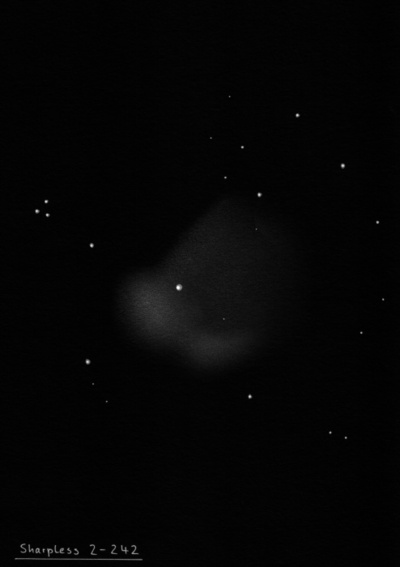The constellation of the northern sky's zodiacal constellation through which the Sun passes before the summer solstice, from May 13 to June 20. At the opposite time of year, late autumn, Taurus is therefore high above the south as it passes through our meridian. Taurus lies just on the edge of the winter Milky Way and is one of the most attractive and distinct constellations in the northern hemisphere. And not just because it is home to two of the most extraordinary open star clusters - the Hyades and the Pleiades - that the Earth's sky has to offer. It's not to be missed in the sky, and it lies in close proximity to Orion. With a little imagination, we can make out an angry bull in the star pattern with the ominous red eye formed by the star Aldebaran, the V-shaped head represented by the open cluster Hyades, and the ominous horns extending northeast to the stars β and ζ Tauri. Taurus is also known for containing G in 1801. Piazzi discovered the first asteroid Ceres.
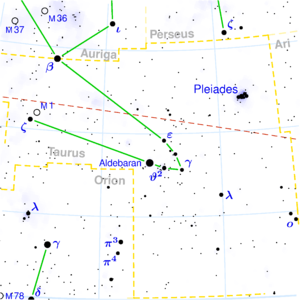 The faint parts of the Milky Way are found in Taurus. One part begins to emerge from around the California Nebula and continues indistinctly east of the Pleiades toward the south. It is separated from the main stream by a darker region. At about 2/3 of the distance from the red Aldebaran towards the star Alnath (β Tauri) there is again a nebulous ring cloud. In the 10 × 50 class, a large open cluster without central compaction, NGC 1746, is also visible and contains several numerous stars.
The faint parts of the Milky Way are found in Taurus. One part begins to emerge from around the California Nebula and continues indistinctly east of the Pleiades toward the south. It is separated from the main stream by a darker region. At about 2/3 of the distance from the red Aldebaran towards the star Alnath (β Tauri) there is again a nebulous ring cloud. In the 10 × 50 class, a large open cluster without central compaction, NGC 1746, is also visible and contains several numerous stars.
Approximately at the boundary of Taurus, Woz, Gemini and Orion is the galactic anticenter, hence the lack of a bright milky background. At l = 175˚ we observe a large molecular cloud complex only 450 light-years away, which in some regions attenuates incoming starlight by up to 30 magnitudes. It consists of a number of Barnard nebulae (B14, 18, 22, 210, 220, 212, 215) and is also a region where new low-mass stars are now forming. An example is the well-known T Tauri, around which the Hind Variable Nebula (NGC 1554 - 55) can be seen in a large telescope.
Aldebaran (α Tau) - The brightest star of the constellation (0.85 mag). An orange giant of spectral class K5, its name is of Arabic origin and means "another" - because it appears after the Pleiades and follows them in their daily motion from east to west. It is located 65 light-years away from us and represents the eye of the Bull in the sky. Its actual luminosity reaches 125 times the luminosity of the Sun. It coincidentally appears to be projected onto the open star cluster Hyades, which actually lies beyond it.
θ Tau - A wide double star in the Hyades visible to the naked eye. It consists of two bright components with magnitudes of 3.6 and 4, separated by 337". The brighter component is white, and the companion is orange. They are separated by 15 light-years, but it is highly likely that they have a common origin.
λ Tau - An eclipsing variable star of Algol type, with a magnitude fluctuation from 3.3 to 3.8 in a period of 3.95 days. Suitable comparison stars are γ (3.6 mag), μ (4.3 mag), ο (3.6 mag), and ζ (3.7 mag). λ Tau is actually much brighter than Algol, but it is located at a much greater distance (480 light years). Its light variations were first observed by J. Baxendell from England in 1848.
47 Tau - A close binary star, even for a telescope with a 200mm objective diameter. Up to 200x magnification will reveal two yellow stars with magnitudes of 4.9 and 7.4, located at a separation of only 1.1". Another star with a magnitude of 12 is located 30" away.
φ Tau - It consists of two stars with magnitudes 5 and 8.4 at a mutual distance of 52.1". A good binocular is sufficient to resolve both components. In a small telescope, we can also observe a yellow or blue tint.
RW Tauri - An eclipsing variable star, one degree northwest of 41 Tauri. The primary component is completely eclipsed every 2.76 days, which reduces its brightness from 7.9 mag to 11.4 mag. The total eclipse lasts for 9 hours, and the entire obscuration persists for an additional 84 minutes. Among eclipsing variable stars, RW Tauri exhibits one of the deepest magnitude decreases, up to 3.5. It is estimated that this system is located 1,370 light-years away.
T Tauri - The observed 1.8 degrees west of ε Tauri, a star at the northern tip of the "V" of the Hyades, is a faint variable star of irregular period, with a mysterious emission / reflection nebula called Hind's Variable Nebula (NGC 1554-55). The brightness of the star changes unpredictably from 8.4 mag to 13.5 mag. T Tauri is a very young star, and NGC 1555 is likely a remnant of the cloud from which it was born. T Tauri and NGC 1555 are located within a relatively close complex of dark clouds in Taurus, about 450-500 light-years away, where other much fainter similar stars are found.
M 1
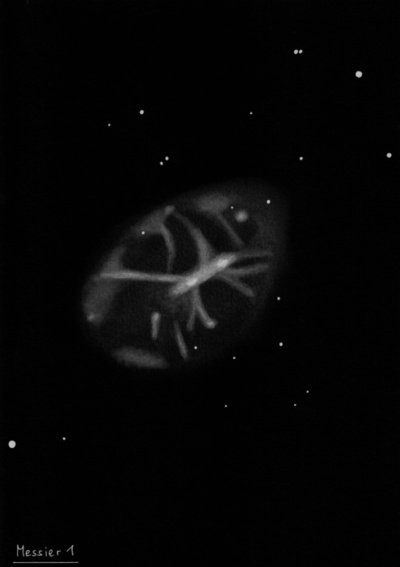
15x50mm IS binoculars (2/23/06): easily visible as a faint, oval patch.
John Bevis discovered M1 = NGC 1952 = h357 around 1731 using a 3-inch (+/-) refractor of 24 ft focal length. He labeled it as a nebula in his Uranographia Britannica star atlas, which was completed in 1750, though not published in 1786. Charles Messier independently discovered M1 on 28 Aug 1758. While searching for comet Halley on its first predicted return, he found instead another comet, which turned out to have been discovered earlier. Then while tracking this comet he found M1, which Messier noted "contains no star; it is a whitish light, elongated like the flame of a taper." Bevis informed Messier of his earlier discovery in 1771. Messier?s rediscovery of M1 was the inspiration to begin the compilation of his catalog.
William Herschel made numerous observations with his various telescopes, though first observed it on 24 Mar 1783 with this 6.2-inch reflector. With his workhorse 18.7-inch he attempted to resolve the nebula into stars: "Very bright, of an irregular figure; full 5 minutes in longest direction. I suspect it to consist of stars."
Much of the following is gleaned from Wolfgang Steinicke's book on "Observing and Cataloguing Nebulae and Star Clusters". William Parsons (third Earl of Rosse) and friends Romney Robinson and James South observed M1 with his first (compound) 36-inch in early November 1840. A few weeks later Robinson wrote Rosse to examine other nebulae as "I am anxious to know whether they all have tails and claws". Parsons sketched M1 in 1844 (using his solid 36") with filaments or streamers extending out of the body and a long tail (see http://messier.seds.org/more/m001_rosse.html). His description reads: ".. a cluster; we perceive in this [36-inch telescope], however, a considerable change of appearance; it is no longer an oval resolvable [mottled] Nebula; we see resolvable filaments singularly disposed, springing principally from its southern extremity, and not, as is usual in clusters, irregularly in all directions. Probably greater power would bring out other filaments, and it would then assume the ordinary form of a cluster. It is stubbed with stars, mixed however with a nebulosity probably consisting of stars too minute to be recognized. It is an easy object, and I have shown it to many, and all have been at once struck with its remarkable aspect. Everything in the sketch can be seen under moderately favourable circumstances."
Romney Robinson, director of Armagh Observatory and a regular observer at Birr Castle, remarked "it is ragged, bifurcated at the top, and has streamers running out like claws in every direction." This description, along with the 1844 sketch, probably led the popular nickname "Crab Nebula".
William Lassell was certainly influenced by the sketch. He observed M1 in December 1852 with his 24" reflector and commented, "long filaments run out on all sides". Three weeks later, he noted "the outlying claws are only just circumscribed by the edge of the field of 6' in diameter." Father Angelo Secchi was also influenced; his sketch made around 1856 using a 9.5" refractor strikingly mimics the 1844 sketch with a long tail and external feelers! Secchi claimed the agreement in features demonstrated the strength of his telescope.
Interestingly, R.J. Mitchell resketched the Crab in 1855 with a much more traditional shape. Dreyer commented in The Observatory, Vol. 37, p. 399-402 (1914), "The only published drawing which is a complete failure, is that of M1, the "Crab Nebula", which has unfortunately been reproduced in many popular books. It was made with the 3-foot, and long "feelers" were never again seen with the 3-foot nor with the 6-foot." Still the nickname stuck. See More http://www.southastrodel.com NGC 1952.htm for more historical observations.
Isaac Roberts first captured M1 photographically in 1892 with his 20-inch reflector.
In 1921 Carl Lampland suspected internal motion and based on plates with the the 40-inch reflector at Lowell, showed the nebula had changed shape. He also discovered the close double star at the center (5" separation).
Also in 1921 Lundmark mentioned (PASP, 33, 234) that the nova of 1054 was near NGC 1952 and in 1928 Edwin Hubble (http://adsabs.harvard.edu/full/1928ASPL....1...55H) stated the nebula "is expanding rapidly and at such a rate that it must have required about 900 years to reach its present dimensions. For, in the ancient accounts of celestial phenomena only one nova has been recorded in the region of the Crab Nebula. This account is found in the Chinese annals, the position fits as closely as it can read, and the year was 1054!" The Chinese text noted "Thereafter, a "guest star" appeared on 4 Jul
In 1937 Nicholas Mayall made a spectral analysis (PASP, 49, 101) and in 1939 (ASPL, Vol 3, 145) announced the Crab Nebula was a supernova remnant.
In 1951 Australian astronomer John Bolton showed that M1 was a strong radio source (brightest in Taurus) and was named Taurus A. In 1968 a pulsar (rapidly rotating neutron star) was discovered in M31 with a period of 33 milliseconds (southwestern of the two central mag 16.5 stars).
200/250mm - 8" (10/4/80): moderately bright, irregular shape, fairly large, indentation on the NW and SE ends.
300/350mm - 13.1" (1/18/85): large, bright, irregular potato shape, large indentation on following end. Easy in 16x80 finder.
400/500mm - 17.5" (2/8/86): very bright, unusual potato shape with an irregular surface brightness, 6'x4', broad concentration towards center. Very irregular elongated shape with extensions or "arms" towards the NW and SE, ragged edges at periphery. A large dark indentation or "bay" intrudes on the NE side of the SE extension, so this end is thinner and less prominent. A few faint stars are superimposed. Using an OIII filter, the overall structure is muted but a bright inner streak is visible in the SW quadrant (oriented ~E-W) and this streak is not noticeable without the filter.
900/1200mm - 48" (10/23/14): remarkable intricate filamentary structure at 488x using a DGM Optics OIII filter. I didn't try to take detailed notes, but the entire surface of M1, which filled over half the field, was resolved into an intertwined maze of thin, twisting filaments. This complex structure was more evident than the view I had a year ago at 287x.
48" (11/2/13): using 488x I immediately focused in on a close unequal mag double star (roughly mag 16/16.5) that was visible near the center but a bit offset from the geometric center towards the SE side of the nebula. The fainter southwest component (CM Tau) is the famous pulsar (rotating neutron star) at the heart of the Crab Nebula, which was discovered in 1968 and pulses 30 times/sec!
Although this observation was exciting (first definite view of the pulsar), the real jaw-dropping sight was at 287x using a DGM Optics OIII filter, which lit up the interior filaments! The two bright filaments that meander E-W through the nebula (dipping just south of the pulsar) were very prominent with slightly fainter side filaments extending south and north. Scanning with averted vision, numerous additional very faint, thin radial filaments extending outward were evident throughout the nebula. In addition, the periphery had a ragged or curdled appearance, particularly along the northern edge. The eypiece view approached the iconic HST image of the Crab Nebula !
Notes by Steve Gottlieb
NGC 1647
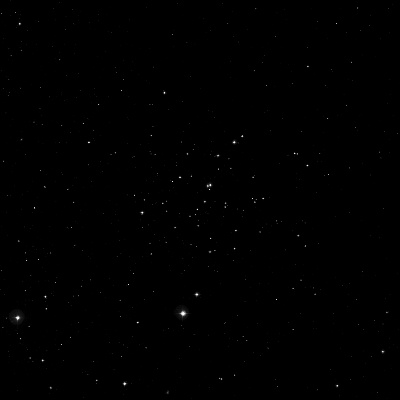
William Herschel discovered NGC 1647 = H VIII-8 on 15 Feb 1784 (sweep 143) and called it "a cluster of scattered stars consisting chiefly of large ones, it takes up above 20' of space; but there is not a great number of them." Sue French notes it was the first object discovered while trying out a new speculum mirror. He wasn't satisfied with the mirror, repolished it, and put it back into action 4 nights later.
300/350mm - 13.1" (1/11/86): about 80 stars in a scattered cluster including several bright stars. Very large, bright. Includes a mag 8.5/8.9 double star at 33" separation in the center. Also includes many faint double stars.
Notes by Steve Gottlieb
NGC 1514
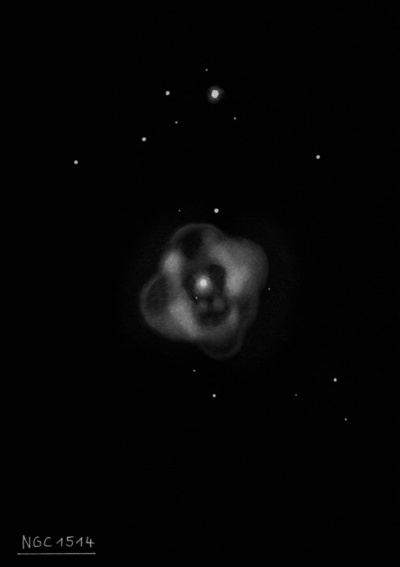
William Herschel discovered NGC 1514 = H IV-69 = h311 on 13 Nov 1790 (sweep 980) and wrote, "A most singular phenomenon. A star of about 8th magnitude with a faint luminous atmosphere of a circular form, and about 3' in diameter. The star is perfectly in the center and the atmosphere is so diluted, faint and equal throughout that there can be no surmise of its consisting of stars; nor can there be a doubt of the evident connection between the atmosphere and the star. Another star, not much less in brightness and in the same field with the above, was perfectly free from any such appearance."
The striking symmetry of NGC 1514 caused Herschel to rethink his idea of planetary nebulae. He previously assumed all nebulae were unresolved stellar clusters of some kind, disguised by their great distance. After this point, he was convinced of the existence of pure nebulosity, out of which individual stars or planets were born and he no longer expected every nebula to be resolved with enough aperture. This essentially destroyed his interest in the 40-foot telescope (48-inch aperture), although the difficulty in using this unwieldy scope was also a major factor.
A total of 20 observations were made with the 72" at Birr Castle with one of the earliest (13 Jan 1852) by Bindon Stoney. He described NGC 1514 as a "new spiral of an annular form round the star, which is central; Brightest part is sf the star, spirality is very faint, but I have no doubt of its existence". Stoney and later R.J. Mitchell sketched an irregular rim with brighter and dimmer sections. Samuel Hunter made a sketch on 9 Jan 1858 with a brighter reversed "S" shape within an oval halo. A version of this sketch was chosen (over Stoney and Mitchell's sketches) for LdR's 1861 publication (plate XXV, figure 7). Resolving spiral structure was a major theme at Birr Castle but irregularities in the rim was likely the cause of this illusion.
300/350mm - 13.1" (12/22/84): bright, fairly large, round, dominated by a mag 9.5 central star.
400/500mm - 17.5" (12/30/99): at 100x, moderately bright, round, ~2' halo surrounding a prominent mag 9.5 star. Displayed an excellent response to UHC and OIII blinking while the H-beta filter killed the PN (OIII/H-beta = 12). Using the OIII filter, the surface brightness was noticeably uneven, with the NW quadrant of the rim clearly brighter. The SE end was also weakly enhanced while the center and ends of the minor axis were slightly darker. At 220x using a UHC filter, the halo appeared nearly 2.5' in diameter. There was a small, darker "hole" surrounding the central star and the halo was clearly irregular with a brighter "knot" on the SE side, while the NW portion of the halo was brighter along the rim.
17.5" (9/14/85): very bright, large, round, 2' diameter. Contains a very bright mag 9.5 central star surrounded by a fairly bright halo with an irregular surface brightness. Located midway between mag 8.3 SAO 57017 8' NNW and mag 9 SAO 57021 8' S.
900/1200mm - 48" (10/25/14): at 610x unfiltered; very bright and large; very irregular surface brightness, the rim varies greatly in thickness and brightness. The relatively thick rim is very bright in the northwest quadrant, along roughly a 70? arc. A second enhanced portion of the rim is along the southeast end (~35? arc) and a third slightly smaller, bright region (more circular) is on the east end. The rim is weak on the south or south-southwest end as well as the north and northeast side. A mag 17 star is at the edge of the rim on the southwest end. A few modest outer lobes were evident; the rim bulges out on the southeast side (near the two enhancements on this end) and to a lesser extent on the northwest and the south end. The mag 9.5 star at the center and a very faint companion to its southeast are surrounded by a darker central hole.
Notes by Steve Gottlieb
NGC 1746
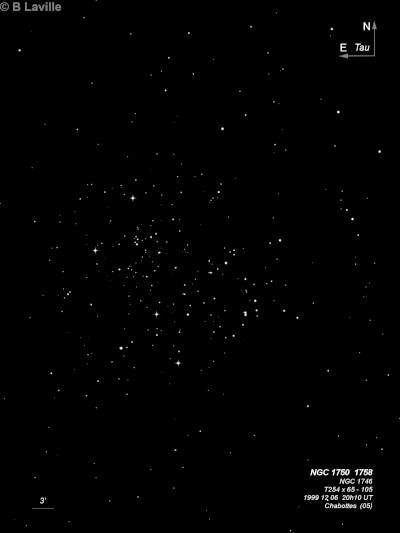
Heinrich d'Arrest discovered NGC 1746 on 9 Nov 1863 with an 11" refractor while searching for NGC 1750 and called it a poor cluster. His position was roughly 10' north of William Herschel's position for NGC 1750 = H. VIII-43 though d'Arrest refers to his "cluster" as H VIII-43. NGC 1746 is often applied to the entire 40' field including NGC 1750 and 1758 on the east side but Harold Corwin suggests that NGC 1746 may indeed be a duplicate of NGC 1750 or perhaps just a group of stars on the north edge of NGC 1750. In any case, it is not a separate cluster from NGC 1750 and 1759, although I've retained the position and size often found in observing books and atlases.
300/350mm - 13.1" (12/22/84): about 100 stars in 20' field. The brightest mag 7 star (HD 32461) at the south edge and there are many nearby bright stars.
400/500mm - 17.5" (2/22/87): very bright, very large, large range of magnitudes, spread out overall but locally rich in a few spots. Includes two main subgroups - NGC 1750 and NGC 1758 - which are probably the only clusters here, along with several mag 7.5-8.5 stars. NGC 1750 consists of two dozen stars on the south side. It appears as a fairly large oval oriented NW-SE with a void in the center and includes a nice mag 9.1/9.1 pair at 20". NGC 1758 is a richer, roundish group of stars close northeast (though probably unrelated physically to NGC 1950) including about two dozen stars. NGC 1758 is bracketed by two mag 8 stars oriented N-S and a mag 7 star is off the east end. Includes five mag 13 stars at the east side.
NGC 1746, although often applied to the 40' field including NGC 1750 and 1758, may in fact be a duplicate of NGC 1750 or just a group of faint field stars noted by d'Arrest while searching for NGC 1750.
Notes by Steve Gottlieb
NGC 1807
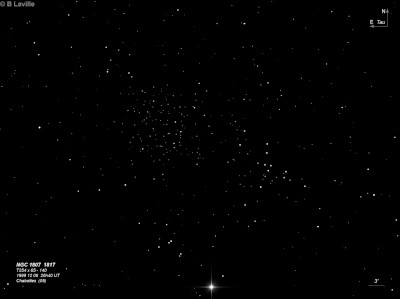
John Herschel discovered NGC 1807 = h348 on 25 Jan 1832 (sweep 395) and logged, "a cluster of 10 or 12 large and a good many small stars. The place that of a double star." It is perhaps an outlier of VII.4 (NGC 1817)." His position is accurate.
A 2004 study ("uvby-H-beta CCD photometry of(NGC 1817 and NGC 1807") concludes NGC 1807 is not a distinct cluster. Only(NGC 1817, a very extended open cluster, covers the area.
200/250mm - 8" ~25 stars in cluster including 10-12 brighter stars, several almost collinear. A double star mag 10/11 at 10" separation is near the center. Forms a pair of open clusters with NGC 1817 25' NE.
400/500mm - 17.5" (2/1/92): bright, moderately large, striking group of 30 stars mag 9-14 in 12' including 10 stars mag 11 or brighter. Five bright stars are in a 11' string oriented N-S. The central star in this string is a pleasing, close double star h3268; consisting of mag 9.5/10.5 stars at 10" separation. This double is collinear with two mag 11 stars 1.3' E and 2.9' E oriented perpendicular to the string. Several other members trail to SW forming a cross asterism.
Notes by Steve Gottlieb
NGC 1817
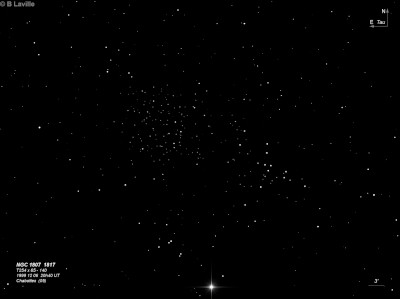
William Herschel discovered NGC 1817 = H VII-4 = h349 on 19 Feb 1784 (sweep 147) and recorded "a cluster of stars, ccattered and of very different magnitudes. They take up a space of about 20' and the cluster is coarsely circular. The weather is very indifferent so that the small stars are not very well to be seen; but I suppose there cannot be less than 150 that I might count at present." On 15 Oct 1784 (sweep 292), he reported "a cl of stars about 20 or 25' diameter, pretty rich, the stars not very small, nor very compressed." On 25 Jan 1832 (sweep 395), John Herschel wrote, "L, rich cl; stars 12...15 m; fills the field. Place that of a double star. The most compressed part is 42.5 sec foll the double star and 3' south of it." The double star is h3269 = 8.6/10.6 at 20".
200/250mm - 8" about 65 stars in 15'-20' diameter, large, fairly rich, many faint stars. Includes three brighter stars on the west side including a mag 8.5 star. Forms a poor version of the "Double cluster" with NGC 1807 25' SW.
400/500mm - 17.5" (2/11/96): large, roundish group of ~100 stars in a 15' diameter. The three brightest mag 8/9 stars lie on the west side. This trio is part of a 7' arc of 15 stars elongated N-S sharply defining the preceding side of the group. The cluster is fairly well detached except at the east side which merges into the general field density. About 5' NW of the trio described above is an unequal double h3269 = 8.6/10.6 at 20", though it appears detached from the main group. 25' SW is the bright, striking group NGC 1807 which has a cruciform outline.
Notes by Steve Gottlieb
NGC 1802
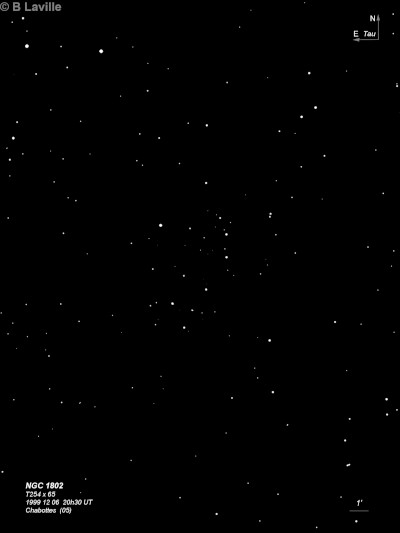
William Herschel discovered NGC 1802 = H VIII-41 on 7 Dec 1785 (sweep 485) and recorded "a coarse cluster of star or projecting point of the milky way." Karl Reinmuth, in his 1926 survey based on Heidelberg plates, adds "many st, v sc, no distinct cl." RNGC classifies the number as nonexistent but WEBDA has a listing for NGC 1802.
400/500mm - 18" (11/18/06): at 115x this Milky Way field appears as a bright, large, scattered group including a couple of dozen mag 10-11 stars. Most distinctive is a fairly rich 5' string of mag 10 to 13 stars oriented N-S. The rest of the group is scattered and extends east and southeast ~10' in size.
Notes by Steve Gottlieb
IC 349
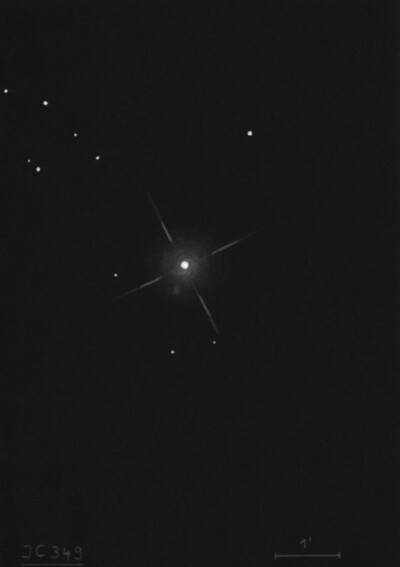
E.E. Barnard discovered IC 349, a fan-shaped knot of nebulosity just 0.6' SSE of Merope, visually on 14 Nov 1890 using the Lick 36" refractor. It was announced in a discovery note in AN 3018. "On Nov. 14 while examining the cluster, I discovered a new and comparatively bright round cometary nebula close south and following Merope, every precaution was taken to prove that it was not a ghost of Merope by examining the other stars of the group under the same conditions. I have since seen it several times and on Dec. 8th I could see it with some difficulty in the 12-inch by occulting Merope with a wire in the eyepiece. With the great telescope the nebula can be seen fairly well with Merope in the field and is conspicuous when the star is placed just outside the north edge of the field. It is about 30" in diameter, of the 13th mag, gradually brighter in the middle, and very cometary in appearance. It was examined with powers of 300, 520 and 1500, with all of which it was comparatively easy."
900/1200mm - 48" (10/31/13): IC 349 is a reflection knot just 36" SSE of Merope. We used 813x and carefully placed Merope barely outside the north edge of the field. The orientation was easy to judge using two 15th magnitude stars 1.8' S and 1.8' SSW of Merope and the elongated glow fell between the diffraction spikes. Despite the glare from Merope making the observation much more difficult, I was surprised this small reflection nebula was fairly bright and elongated (roughly pointing south from Merope) with a straighter western edge, perhaps 20"x10" in size.
Notes by Steve Gottlieb
NGC 1587
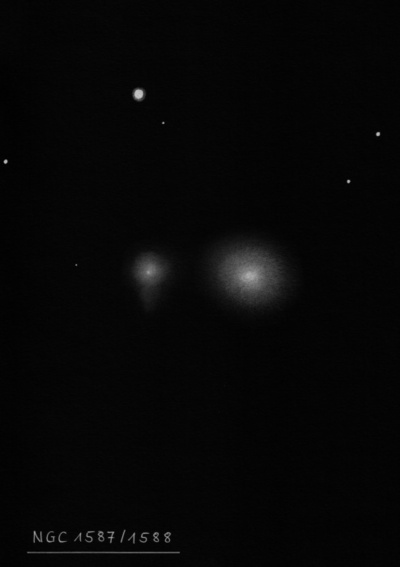
William Herschel discovered NGC 1587 = H II-8 = h316, along with NGC 1588 and 1589, on 19 Dec 1783 (early sweep 54). He noted "Two close together [with NGC 1588], 3/4? north of 45 Eri." His summary description (from 4 sweeps) reads "Two [with NGC 1588]. The first F, S, r." On 23 Nov1827, John Herschel called this object "the south-preceding of a double nebula; R; pL; distance of centres 60"."
300/350mm - 13.1" (12/22/84): moderately bright, small, almost round, small bright core. Forms a pair with NGC 1588 1' E. NGC 1589 lies 12' N. Located midway between 44 and 45 Tauri.
400/500mm - 17.5" (2/3/03): fairly bright, moderately large, slightly elongated SW-NE, 1.2'x1.0', well-concentrated with a very bright core and stellar nucleus. Forms a close pair with NGC 1588 0.9' E. In a trio with NGC 1589 12' N. NGC 1587 is the brightest member of the LGG 117 galaxy group (z = .012)
Notes by Steve Gottlieb
NGC 1409
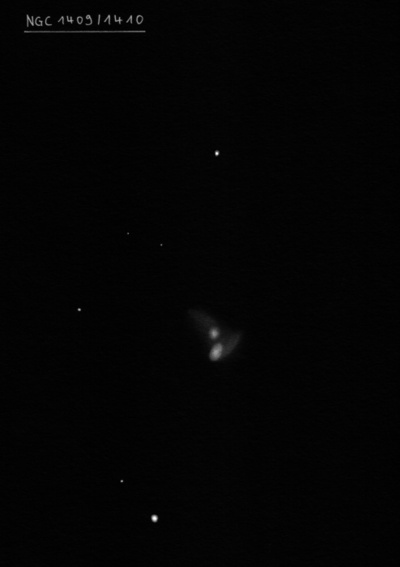
William Herschel discovered NGC 1409 = H III-263 = h304 on 6 Jan 1785 (sweep 351) and logged "Suspected, eF, stellar or lE, 240x power rather confirmed it, but left a doubt." His position is 2' south of this double system (with NGC 1410).
400/500mm - 17.5" (10/24/87): faint, small, oval SSW-NNE. This is a contact pair with NGC 1410 - just 14" between centers. At high power appears faint, small, round, small bright core. NGC 1410 is just 15" NE in a common halo. Located on the Eridanus border.
Notes by Steve Gottlieb
IC 331
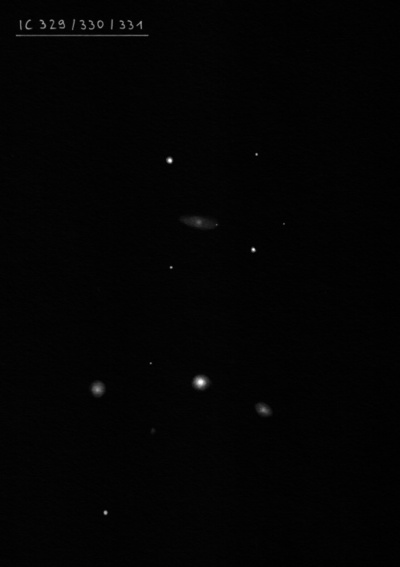
Stephane Javelle discovered IC 331 = J. 2-117, along with IC 329 and IC 330, on 4 Dec 1891. He reported "mag 13 star surrounded by nebulosity, nebulous character uncertain."
600/800mm - 24" (12/1/16): at 225x; fairly faint, fairly small, round, very small bright nucleus. IC 331 lies 2.6' E of mag 8.3 HD 21926 and is the third in a trio with IC 329 (2' WSW of the bright star) and IC 330. It's slightly brighter and larger than IC 329. Although none of these galaxies are bright, the arrangement with the bright star is striking.
Notes by Steve Gottlieb
NGC 1435
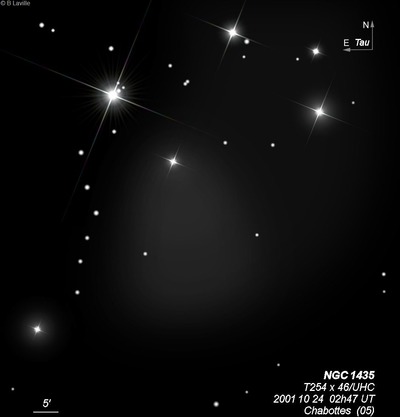
Wilhelm Tempel discovered NGC 1435, the Merope Nebula, on 19 Oct 1859 from Venice with his personal 4-inch Steinheil refractor using 45x. The following historical summary is from Wolfgang Steinicke's book "Observing and Cataloguing Nebulae and Star Clusters".
The Merope Nebula was the first deep sky object Tempel discovered. He initially thought it was a comet, but the next night (20th) he checked and found no movement. The discovery was published on 23 Dec 1860 (AN 54, 285). Christian August Peters, the editor of Astronomische Nachricten, confirmed the observation using a 7-inch refractor. Auwers first observed it on 14 Jan 1861, but d'Arrest was unsuccessful using the 11-inch Merz refractor at Copenhagen in Aug 1862. Based on his negative results on several attempts, he reported "I have hitherto been able positively to see nothing. ...I therefore, even yet, am of opinion that this nebula is variable, otherwise the original announcement of the discovery ... must be looked upon as been greatly exaggerated. This report began a heated interchange involving many of the world's most prominent visual observers over the next 30 years (see NGC 1555 = Hind's Variable Nebula for a similar situation).
In September 1862, Julius Schmidt supported d'Arrest, claiming if it was not variable he would have noticed it while carefully observing the Pleiades since 1841. He first reported a sighting on 5 Feb 1861, describing it as "very large, very pale and quite shapeless." Auwers responded critically to d'Arrest, claiming neither Tempel's (Merope) nebula nor NGC 1333 were variable but that "large, blurred, faint objects are much more easily visible in small instruments than in large ones" and d'Arrest's failure was due to "a small field of view, completely filled by the 15' large nebula". Charcornac at Paris Observatory also reported the nebula was difficult to see at high power. Sch?nfeld wrote that the nebula "instantly stuck out in the local telescope (6.5-inch refractor in Mannheim, Germany) on Sept 20, 1862 when I pointed it freely towards Merope, without knowing the exact place, looking like a blurred nebula with the shape and size described by Auwers."
d'Arrest responded to the attack on 12 Nov 1862 (AN 1393) stating "after a long effort I actually set eyes on Tempel's Nebula", though it was "the faintest object which I remember ever having seen in the refractor". He was "still convinced that the nebula was variable; otherwise the discovery report ["large, bright nebula"] must be seen as highly exaggerated." In March 1862, Winnecke viewed the nebula with a 4.1-inch refractor at low power and asked Otto Struve to take a look in the 15-inch Merz refractor, convinced that it would be difficult to see in the larger scope. Winnecke noted "Indeed, we were not convinced about its existence until the telescope was moved quickly back and forth". Winnecke concluded there was no reason to invoke variability to explain the observations. In 1863, Tempel wrote a letter to the French magazine Le Monde asserting that nebulae, in general, are unchanging (otherwise their constituent stars would have to be vary simultaneously) and that atmospheric conditions were the source of different observational results.
Reverend Thomas Webb observed the nebula on 6 Oct 1863 with his 5.5-inch Clark refractor, stating "on turning the telescope upon the group at 29x and 64x, though I probably should not have it discovered unknown, I found it with ease, as a very ill-defined, but on the whole egg-shaped haze, encompassing a brilliant star with its smaller but rather brighter end." As far as the variability "he [Sch?nfeld] thinks this and other suspected nebulae, being very feeble, large and diffuse, are influenced in visibility by magnifying power, varying transparency of the air, and practice of the eye, so that aperture is less concerned in their case than in that of minute stars." Although he never observed the nebula, John Herschel catalogued the Merope Nebula as GC 768 and his description stated "VAR" [variable].
The controversy about the variability and GC entry caused Lawrence Parsons (4th Earl of Rosse) to take a look with the 36-inch and 72-inch reflectors at Birr Castle, but he found no nebulosity in five observations from Feb 1871 to Sep 1873! Dreyer, himself, was unsuccessful (on a "misty" night) on 24 Dec 1875. The first (marginal) successful observation at Birr Castle was not made until 10 Dec 1877 and confirmed later that month.
The debate over variability wasn't settled. In 1875 Charles Wolf at Paris Observatory reported he was unable to see the Merope Nebula from Nov 1874 to Feb 1875 and Stephan at Marseille confirmed this. Wolf concluded, "This nebula is truly variable and its period seems to be rather short". But Tempel published another report in Jan 1877 (AN 2139) concluding, "the invisibility of the Merope Nebula in a large telescope is due to the eyepiece and its field of view. If d'Arrest had used an eyepiece of lower power than 95x, giving a field of 20 to 25'; he would have seen the nebula very easily." Tempel also made disparaging remarks about the large reflectors at Birr Castle, claiming the 36-inch and 72-inch didn't show more stars than his 11-inch Amici refractor (Tempel and Dreyer had a bitter dispute in 1878 about the "spiral form of nebulae", which Tempel couldn't see in his 11-inch).
On 6 Mar 1877, Maxwell Hall drew the nebula with his 4-inch refractor at 100x and was amazed it was invisible to Lord Rosse and Robert Newall, who had a 25-inch Cooke refractor. Hall was also critical of Schiaparelli's description of the orientation of the nebula. Hall's article touched off another debate between Wolf, Common, Hough, Tempel, Swift, Barnard and Burnham.
Charles Wolf published his work on the Pleiades and included a sketch made in Nov 1875. He saw nebulosity extending to Electra and Celaeno, by masking Merope with the micrometer bar. A much earlier report by Hermann Goldschmidt to Leverrier in Paris on 21 Sep 1863, claimed he saw not only the Merope nebula but that the Pleiades were completely surrounded by diffuse nebulosity, extending over an area of 5?.
In 1880, Ainslie Common published a drawing of the Pleiades nebulosity using his 36-inch reflector. It showed a large, elongated patch SE of Merope (the wrong direction!) and two additional patches; one north of Merope and another to the NW of Alcyone. This caused some more controversy.
In 1880, Tempel published (MNRAS, 40, 622) an excellent drawing of the nebula using Amici I, with accurate form and brightness levels, along with a large number of nearby faint stars. He mentioned the various astronomers who confirmed the object, including Schmidt, Winnecke Auwers and Sch?nfeld, and also opponents such as d'Arrest, Secchi and the Birr Castle observers. He stated "But all ambiguity has been since cleared up, for on fitting the large telescopes with eyepieces of a low magnifying power the nebula becomes distinctly visible, and is shown by them with image equal in clearness to that given by the smaller instrucments. He also criticized Goldschmidt's observation of the Pleiades surrounded by nebulous clouds and the drawing of Common, saying the sketch must have "evidently been executed with a telescope of insufficient power to show the Merope Nebula." He concluded with satisfaction "It is now ascertained beyond question that the nebula exists...and anyone publishing statements about its non-existence merely uses vain words, and proclaims himself wanting in knowledge of the history and nebulae and the management of telescopes."
Common was offended and responded the "three-foot telescope" mentioned in his report was of three-foot aperture! Hall wrote one more report on 13 Dec 1880, claiming the nebula had changed shape, now "extending as far as Electra, and the parabolic form of the Nebula, as seen 1877, was destroyed." He wondered why Tempel had overlooked the "extension of the nebula in the direction of Electra."
Amazingly, the controversy of the existence of the Merope Nebula wasn't over. At Dearborn Observatory in Chicago, Hough and Burnham had previously been critical of earlier reports, because of their discordant descriptions and their negative results in 1879 and 1880 using the 18.5-inch Clark refractor at 120x and higher. After Tempel's paper, they made a concerted effort from 29 Nov 1880 to 22 Mar 1891 with various eyepieces, stopping down the refractor to 12-inch, even masking Merope. But they came up empty and decided the previous positive observers were misled by the glare from Merope and the neighboring stars! Dreyer immediately responded, criticizing the large exit pupil used and furthermore he didn't see anything unusual about or contradictory about previous published reports of a "large and diffused nebulosity". Also, the theory about the glare from Merope causing an illusion was rejected. Swift also responded on 2 Dec 1881, that he independently ran across the Merope Nebula in 1874 while searching for comets with his 4.5-inch refractor and "strongly suspected it was a new comet." His analysis was that Hough and Burnham used too high of a power as he could see the nebula even stopped down to 2-inch aperture at 25x.
Barnard observed and drew the Merope Nebula and nearby stars with his 5-inch refractor in 1883. He wrote "it is plainly visible in my 5-inch refractory, it has been seen with a 2.5-inch telescope, in the presence of a quarter-full moon." He criticized Common's sketch but felt his sketch agreed with Tempel's (though it extended further west past Electra). Barnard also mentioned that Trouvelot reported that it is variable and had become very faint (he described the nebula as changing to a dim purplish color) and "can now be seen only by those acquainted with its former appearance"!
Paul and Prosper Henry first photographed the Pleiades on 16 Nov 1885 and revealed additional nebulosity around Maia, later catalogued as NGC 1432 (the only photographic discovery in the NGC) as well as faint nebulosity near Electra. In 1886 Charles Wolf published a comparison between the photographic image and the visual observations that showed significant changes in the Merope Nebula. Morever, the separate nebula observed by Goldschmidt and Wolf had disappeared but he concluded that photographic and visual observations can never be reconciled as objects invisible on photographs can exist visually. Surprisingly, the image most closely resembled the ridiculed drawing of Common. Common wrote that his sketch showed the Maia Nebula, however the connection is poor - his placement is closer to Alcyone than Maia.
The image encouraged others to search for addition nebulae in the Pleiades. On 26 Feb 1886, Spitaler and Palisa in Vienna reported the Maia nebula appeared as a "small flaky nebulosity, completely separated from Maia" and on 3 Mar, the former was "only the brightest knot of an extended nebulosity, completely covering Maia." Spitaler wrote "one can hardly refrain from thinking that at least the whole Pleiades region west and north of Alcyone is covered by an extended nebulosity, of which all previously perceived, apparently isolated nebulae, are merely bright knots of light."
On 23 Oct 1886 Isaac Roberts took a 3 hour exposure which revealed "not only are the stars [Alcyone, Maia, Electra, Merope] surrounded by nebulae, but the nebulosity extends in streamers and fleecy masses, till it seems almost to fill the spaces between the stars, and to extend far beyond them." Common again felt vindicated and repeated his treatment by Tempel, "who thought I had not used a sufficiently large telescope" (a misunderstanding by Tempel).
Another image was taken by the Henry brothers in 1888 showing extensive nebulosity. At an RAS meeting on 8 Jun 1888, Common says "I immediately compared my sketches with it and found that every star I had seen, except one, was there, and, of course, in their proper places." Robert Newall, who also attended the meeting, stated he was certain that his observations differed from Common with Merope appearing as an oval comet with Merope at the focus and he had not seen the additional patches claimed by Common.
In an 1888 issue of Knowledge, English astronomer Arthur Ranyard wrote an article titled "Great Nebula in the Pleiades" and stated "The observations are worth examining, as they throw some light on the differences which are always likely to exist when observations are pushed into the border-land of vision, where by reason of the extreme faintness or minuteness of the objects examined, the eye begins to fail, and the imagination begins to play a larger and larger part in filling up the gaps where the senses of the eye-straining observer fail him."
Maxwell Hall made a late interesting set of observations in 1889 in Jamaica. He compared the view of the Merope Nebula using a 9-inch reflector with a glass mirror and his 4-inch Cook refractor. He reported "a glance through the refractor showed the well-known nebula projected against the dark background or field of view; but in the reflector there was so much light scattered around the field of view that the nebula was invisible." He concluded this explained the positive sightings in smaller refractors and vice versa, the failure with larger reflectors (especially Lord Rosse's initial failures). In 1891, Spitaler reviewed the major observations of the Pleiades nebulae in a 20-page paper and created a remarkable map of the region, showing extensive nebulosity surrounding the Pleiades. He argues his map shows the main structures were correctly drawn and generally only the boundaries vary.
IC 349 is a knot of nebulosity just 0.6' SSE of Merope discovered and sketched by Barnard in 1890 using the 36-inch refractor at Lick. The discovery was published in AN 3018. See WSQJ July 1992. In terms of distance, Steinicke notes this is the closest NGC object.
200/250mm - 8" (10/4/80): very large, faint, very elongated tear-drop shaped nebulosity extending SW away from Merope. Has a sharper edge along the eastern side. Best view using the Rich Field Adapter at 37x-50x.
400/500mm - 17.5" (3/2/02): at 100x, the Merope Nebula is the brightest of the reflection nebulae that encase the Pleiades. It appears as a moderately bright, very large, fan-shaped cone of light extended in a wedge SW to SE from Merope. The boundary of the nebulosity is straighter and better defined along the SE edge where it follows a string of mag 10-11 stars. The SW border is not as well defined but extends beyond a trio of mag 13 stars. The fan is broadest at its southern extremity which is roughly 15' from Merope.
16x80 (12/22/84): the Merope nebula was faint but definite in the 16x80 finder using a Deep Sky filter. Also, nebulosity surrounding other stars were confirmed with confidence at full aperture in the 13.1" at 62x.
600/800mm - 24" (12/28/16): at 124x (unfiltered): the huge Merope Nebula was easily visible, roughly spanning 20' in a wedge or triangular shape with mag 4.2 Merope close to the northeast vertex. The most well defined edge is clearly the eastern side as it extends N-S. The edge passes close to a string of 7 stars oriented NNW-SSE, including two mag 10 stars and nearly reaches mag 8.1 HD 23512, which is 20' SSE of Merope. Just before reaching this star the nebulosity clearly curves to the west and extends ~20' generally northwest, passing north of mag 9.0 HD 23326, though the border is slightly less defined. At this point the edges of the nebulosity can be traced back east or ENE back to Merope, though the edge here is the least defined. The surface brightness of the interior is irregular with some slightly brighter patches and weaker areas.
Notes by Steve Gottlieb
NGC 1555
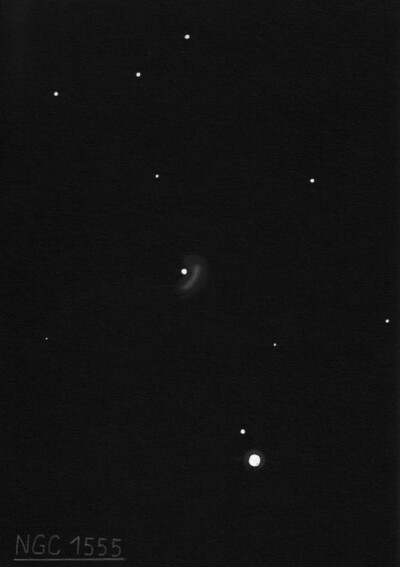
Hind's Variable Nebula was discovered (along with T Tauri) by John Russell Hind on 11 Oct 1852 with a 7-inch refractor. Because of it's variability, disappearance in the early 1860's, and eventual recovery by Barnard in 1890, it was a subject of fascination and numerous journal reports by most of the major great visual observers of the time including d'Arrest, Tempel, Charconac, Auwers, Secchi, Lassell, Struve, Winnecke, Lawrence Parsons, Dreyer, Barnard and Burnham.
John Russell Hind discovered NGC 1555 = Au 20 = Hind's Variable Nebula, which surrounds the variable star T Tauri, on 11 Oct 1852 with the 7-inch Dollond refractor of George Bishop. He reported in AN 839 a "very small nebulous-looking object...; it was south-preceding a star of 10th mag, which to my surprise, has escaped insertion on the map for 4h R.A. recently published - possibly it may be variable." Hind had discovered the young variable T Tauri and the variable reflection nebula NGC 1555. The following summarizes the visual history of this object as told by Wolfgang Steinicke in his "Observing and Cataloguing Nebulae and Star Clusters".
Jean Charcornac confirmed the existence of the nebula in 1854 at Marseilles, likely using a 4-inch refractor. It was probably independently found by James Breen with a 12-inch refractor at Cambridge in 1855. Heinrich d'Arrest first observed the nebula on 3 Nov 1855 in Leibniz and described "a pretty bright nebula, 4' diameter, star 10 at its northern end" and made several additional observations in 1856. Arthur Auwers made 7 observations between 7 Jan and 3 Mar 1858 with a 4.3-inch refractor. He noted the nebula "was visible quite easily and without difficulty, but much fainter than it must have been appearing [to d'Arrest] in 1855 and 1856. He later concluded that it reached its maximum brightness in 1856. He listed it as #20 in his 1862 catalogue of new nebulae and reported the observations in his notes section.
By 1858, though, there was some fading as Charcornac could not recover it at Paris with the 10-inch refractor. It was not seen with confidence by Eduard Sch?nfeld in Feb 1861 using the 6.5-inch Steinheil refractor at Mannheim Observatory. Auwers was unsuccessful in 1861 with a 6-inch Fraunhofer and so was d'Arrest with the 11-inch Merz refractor in 1861-62. Leverrier and Charcornac failed to see nebulosity with the 12.4-inch refractor at Paris Observatory or the new 31.5-inch silver-on-glass reflector in Jan-Feb 1862. Father Angelo Secchi also failed in Rome using the 9.4-inch Merz refractor in Jan 1862. His report suggested a connection between the fading of the variable star and the nebula, shining by reflected light. William Lassell made an unsuccessful attempt with his 48-inch from Malta in Mar-Apr 1862. Hind made another attempt on 12 Dec 1863 in excellent conditions, but failed.
The only reported (barely) successful sighting of the nebula during 1861-62 was by Struve and Winnecke using the 15-inch Merz refractor in Pulkovo on 29 Dec 1861 and more easily on 22 Mar 1862, when a sketch was made. When Struve visited Lassell on Malta, they took a look again on 10 Oct 1863 with the 48-inch and could discern "three or four individual masses separated from each other by black sky", so Struve felt Lassell may have previously looked in the wrong place. "Hind's wonderful nebula in Taurus" was reported to the general public by Reverend Thomas Webb in 1864 in the popular magazine Intellectual Observer and the same year it was catalogued by John Herschel (who never saw it) as GC 839 and he reported on the history in the Notes section. In 1865 and 1866, Vogel made several observations (both positive and negative) in Leibniz with 4.6-inch and 6.5-inch refractors and reported very different degrees of visibility. But during the same time frame and into 1867 it was not seen by Sch?nfeld in Mannheim and was completely invisible to Struve on 14 Mar 1868 at Pulkovo, though he reported a new nebula (Stuve's "Lost Nebula", NGC 1554). Winnecke made a marginal observation in 1875 and sketched it with certainty in 1877. Tempel observed the field in 1877, made a map of the region including his and others observations, but apparently included nonexistent stars and nebulosity which he recorded.
Hind's Variable Nebula wasn't seen again until 1890 when it was barely recovered by E.E. Barnard and S.W. Burnham using the Lick 36-inch refractor. Barnard confirmed a very small, but "conspicuous and definite" glow (only 4" diameter) surrounding T Tauri, which he assumed was NGC 1555, and an excessively faint, round, larger nebula close south that they took as new, but was actually the real NGC 1555. The larger glow was observed again in 1891 by Burnham in 1891 and by Barnard in February 1895, when he finally realized that the faint object just south of T Tauri was actually Hind's Variable Nebula, (barely) visible again. But on three attempts in Sep 1895 ("under the finest conditions") he could find no trace of the nebula. Three years later in Sep 1898, Barnard made additional observations with the 40-inch Yerkes refractor and reported a tiny nebula attached southeast of T Tauri. The first photograph showing nebulosity was made by Keeler on 6 Dec 1899 and three patches were recorded (two corresponding with Barnard's sketches), but no sign of Struve's Lost Nebula. Carl Wirtz was unsuccessful in 1906 seeing either NGC 1554 or 1555 in a visual attempt using the 19-inch Merz refractor at Strausberg as well as by S.W. Burnham in 1907 using the 40-inch Yerkes refractor. Dreyer discussed many of the original visual observations in the NGC, IC 1 and IC 2 Notes section. In 1936, it was mentioned in the Carnegie Institute Yearbook that NGC 1555 "have been under observation by Baade and Hubble...About 1920 the region of the knot D in Pease's diagram (Mt. Wilson Contributions, No. 127) began to brighten and can now readily be seen in the telescope". I assume they mean visually in the 100-inch!
Modern sources often group NGC 1554 and 1555 (discovered by Struve) together, although there is no nebulosity visible on the Sky Survey at Struve's position for NGC 1555. The RNGC RA for NGC 1554 and NGC 1555 is 1.0 min of RA too far east.
400/500mm - 17.5" (11/10/96): this is Hind's Variable (reflection) Nebula, illuminated by T Tauri (9-13). At 100x and 140x (unfiltered) an extremely faint haze was highly suspected on the west or west-southwest side of T Tauri (mag 9) in the direction of a mag 14 star to the west or slightly south (this star is at the position of NGC 1554 = "Struve's Lost Nebula"). No details in the nebula were visible at 100x (it did not appear as an arc) but a sketch made at 100x exactly matched the orientation of the nebulosity with respect to T Tauri. Nebulosity was not visible at 220x and no nebulosity was noted following T Tauri.
600/800mm - 24" (1/12/13): at 200x unfiltered, Hind's Variable Nebula was immediately seen as a very faint, fairly small, elongated haze, roughly 40" in length and slightly curved or bowed out to the west. The variable reflection nebula seemed unevenly lit, though it was too faint to see any specific details. This famous nebula is illuminated by T Tauri (mag 10-10.5), just 35" to the east. T Tauri is perfectly collinear with mag 8.4 HD 27560 5.6' SW and a mag 12 star 4.7' SW. The nebula has likely brightened since the view in 1996 with my 17.5".
900/1200mm - 48" (10/29/19): at 375x, this variable nebula was immediately seen as a diffuse, elongated patch just west of T Tauri. But the scope was shaking from the wind and the seeing was poor, so details were lacking.
Notes by Steve Gottlieb
NGC 1750
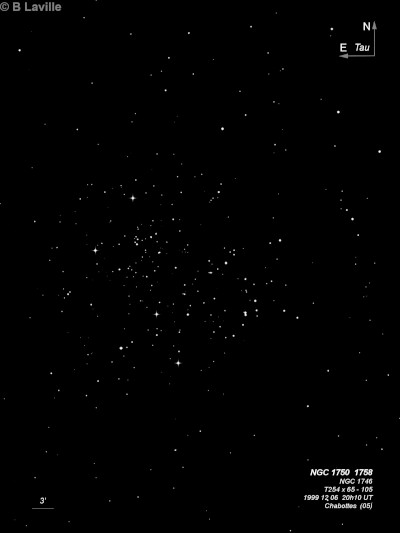
William Herschel discovered NGC 1750 = H VIII-43, along with NGC 1758, on 26 Dec 1785 (sweep 493) and described a "A cl of very coarsely scattered L *, joining to the following [VII 21 = NGC 1758] I believe." His position indicates NGC 1750 is the large, elongated group of stars centered at 05 03 55 +23 39.5, just southwest of NGC 1758. Although NGC 1750 is generally taken as a subgroup (on the SE side) of much larger NGC 1746, Corwin suggests that Heinrich d'Arrest's NGC 1746, which was found while searching for NGC 1750, is actually a duplicate of NGC 1750. Karl Reinmuth, in his 1926 survey based on Heidelberg plates, states that NGC 1750 is the central group in a very large cluster also containing NGC 1746 and NGC 1758.
300/350mm - 13" group of fainter stars, just SE of open cluster NGC 1746.
400/500mm - 17.5" (1/19/91): prominent subgroup of two dozen stars within NGC 1746 on the SW side. Fairly large, oval outline oriented NW-SE, void in the center. Includes a nice double star 9.1/9.1 at 20". NGC 1758 is close NE (though probably physically unrelated ). Modern catalogues apply NGC 1746 to the entire cluster (see description), although NGC 1750 (from William Herschel) and NGC 1746 (from d'Arrest) are either identical or just parts of the same cluster.
Notes by Steve Gottlieb
Mel 25
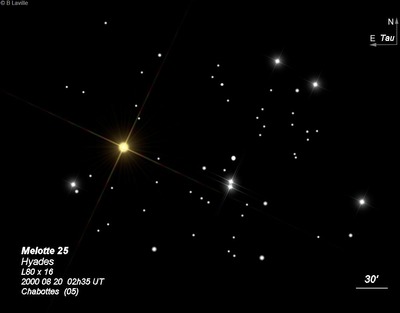
| Type | OC [II3m] |
| RA | 04:26:60.0 |
| Dec | +16:00:00.0 |
| major_axis | 330.0' |
| mag | 0.5 |
M 45
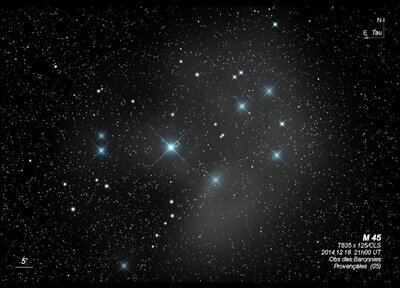
| Type | OC [I3rn] |
| RA | 03:47:00.0 |
| Dec | +24:07:00.0 |
| major_axis | 100.0' |
| mag | 1.2 |
| surface_bright | 11.0 |
HCG 33
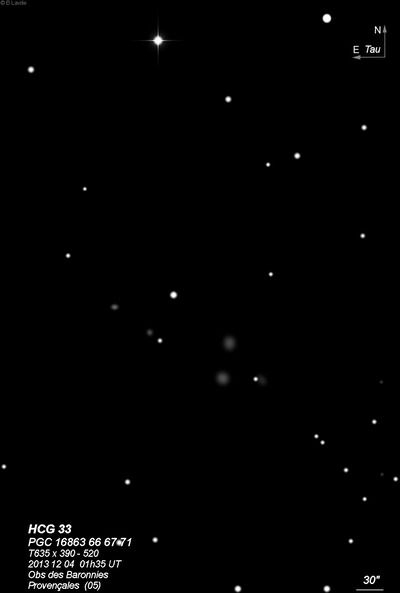
| Type | GALCL [E3] |
| RA | 05:10:47.9 |
| Dec | +18:02:05.0 |
| major_axis | 2.7' |
| mag | 12.4 |
| surface_bright | 99.9 |
Ba 1
| Type | PN |
| RA | 03:53:36.5 |
| Dec | +19:29:39.0 |
| major_axis | 48.0'' |
| mag | 14.3 |
| surface_bright | 13.1 |
H 3-29
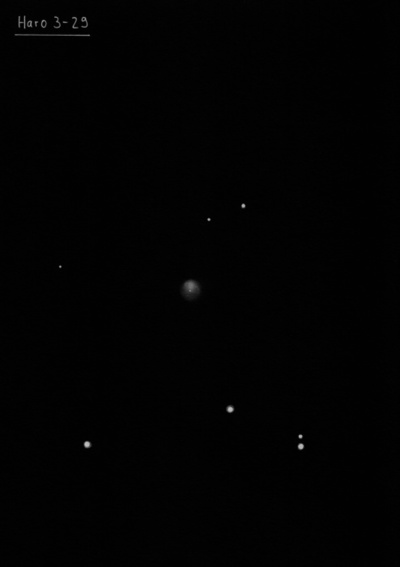
| Type | PN |
| RA | 04:37:23.6 |
| Dec | +25:02:44.0 |
| major_axis | 24.0'' |
| mag | 15.3 |
| surface_bright | 13.1 |
Sh2-240
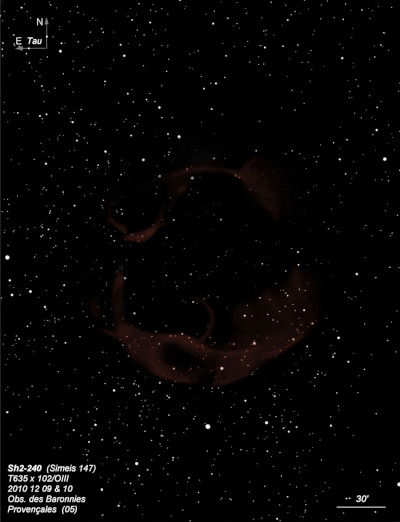
| Type | BN [HII] |
| RA | 05:41:00.1 |
| Dec | +28:06:20.0 |
| major_axis | 180.0' |
